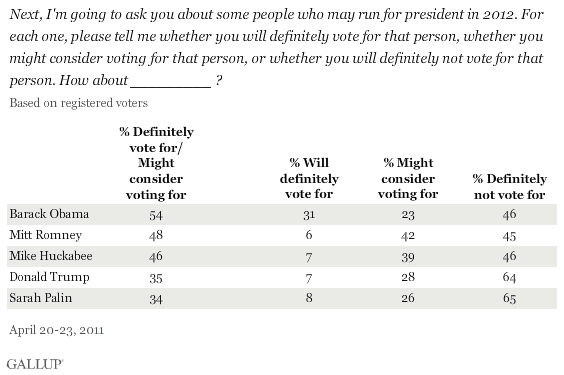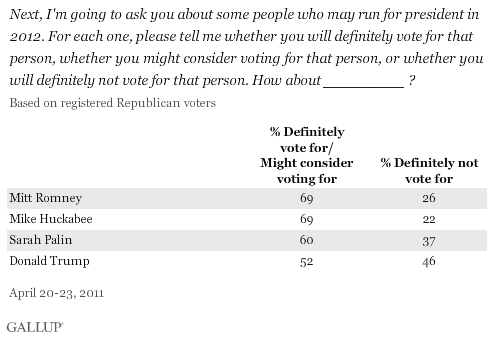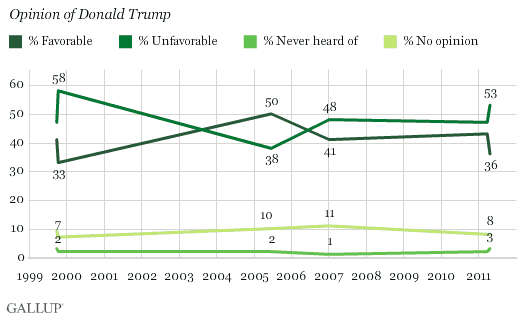PRINCETON, NJ -- More than 6 in 10 registered voters nationwide say they would definitely not vote for Donald Trump or Sarah Palin for president in 2012, significantly more than say the same about possible Republican candidates Mitt Romney or Mike Huckabee, or about President Barack Obama.

None of the four potential Republican candidates measured in the April 20-23 USA Today/Gallup poll has officially announced that he or she is running for president, although none has ruled out a possible candidacy. Trump, however, has been highly visible in recent weeks, talking openly about the possibility of a presidential bid while focusing heavily on the issue of President Obama's birthplace.
The majority of U.S. voters at this point do not appear receptive to a Trump presidency. Sixty-four percent of registered voters have essentially rejected the television personality and businessman, saying they would definitely not vote for him. That leaves Trump with 7% of voters who say they definitely would vote for him, and another 28% who say they might consider it.
About as many voters nationwide (65%) say they would definitely not vote for former vice presidential candidate, former Alaska governor, and current television personality Palin.
President Obama fares better than any of the four Republican candidates on this measure. Fifty-four percent of registered voters say they would consider voting for Obama, including 31% who would definitely vote for him, while 46% say they would definitely not vote for him.
Romney and Huckabee are in somewhat more positive positions than either Trump or Palin, but neither is positioned as well as Obama. Less than half of registered voters say they would definitely not vote for either of these two possible GOP candidates.
Almost Half of Republicans Definitely Would Not Vote for Trump
Trump flirted with the idea of running for president in 1999, when most of the speculation centered on the possibility that he would run as a third-party candidate. This year, by contrast, Trump is talking about running for the GOP nomination.
Gallup finds that Trump ties Huckabee for the lead when Republicans are given a list of possible GOP candidates and asked which one they are most likely to support. But Trump's tie on that measure reflects a widely dispersed Republican vote, and he and Huckabee "win" the trial heat based on receiving just 16% of Republican votes each.
While 52% of Republicans would consider voting for Trump, 46% already say they would definitely not vote for him, worse than their attitudes toward Huckabee, Romney, and Palin. This measure of the projected voting patterns of Republicans thus does not look encouraging for Trump.

Trump's Image Now More Negative
Trump's image among all Americans has become more negative over the last several weeks -- a time during which he has ramped up his media appearances and encouraged widespread speculation about his possible presidential bid.
Americans were about evenly split in their views of Trump in late March. Now, in the April 20-23 USA Today/Gallup update, Trump's image has deteriorated; 36% of Americans view him favorably, while 53% view him unfavorably.

Trump would be even more visible should he declare officially that he is running for the presidential nomination, but the current trends suggest that such visibility would not necessarily be positive for his image.
Republicans' views of Trump have remained almost exactly the same between the March and April surveys, with 51% now viewing him favorably. However, independents' and Democrats' views of Trump have worsened considerably between the two surveys. Trump's favorable rating dropped 11 percentage points among independents, to 33%, and 8 points among Democrats, to 26%. This most likely reflects a growing perceived connection between Trump and the GOP arising from the widespread discussion of his possible run for the Republican nomination.
Implications
Trump's attention-grabbing, high-visibility statements and his ability to generate large amounts of news coverage cut two ways. On the one hand, Trump has undeniably dominated news coverage of the Republican race in the last several weeks, vaulting him into the middle of political and election news discussion and coverage. On the other hand, Trump's ability to generate publicity apparently has its costs, as his image has turned more negative and as more than 6 in 10 voters across the country already say they would definitely not vote for him.
Trump also faces apparent obstacles in his efforts to gain the Republican nomination, should he decide to run. Almost half of Republican registered voters at this point say they would definitely not vote for him, the highest of any of the four possible GOP candidates measured in this survey.
Survey Methods
Results for this USA Today/Gallup poll are based on telephone interviews conducted April 20-23, 2011, with a random sample of 1,013 adults, aged 18 and older, living in all 50 U.S. states and the District of Columbia.
For results based on the total sample of national adults, one can say with 95% confidence that the maximum margin of sampling error is ±4 percentage points.
For results based on the total sample of 902 registered voters, one can say with 95% confidence that the maximum margin of sampling error is ±4 percentage points.
Interviews are conducted with respondents on landline telephones and cellular phones, with interviews conducted in Spanish for respondents who are primarily Spanish-speaking. Each sample includes a minimum quota of 400 cell phone respondents and 600 landline respondents per 1,000 national adults, with additional minimum quotas among landline respondents for gender within region. Landline telephone numbers are chosen at random among listed telephone numbers. Cell phones numbers are selected using random digit dial methods. Landline respondents are chosen at random within each household on the basis of which member had the most recent birthday.
Samples are weighted by gender, age, race, Hispanic ethnicity, education, region, adults in the household, and phone status (cell phone-only/landline only/both, cell phone mostly, and having an unlisted landline number). Demographic weighting targets are based on the March 2010 Current Population Survey figures for the aged 18 and older non-institutionalized population living in U.S. telephone households. All reported margins of sampling error include the computed design effects for weighting and sample design.
In addition to sampling error, question wording and practical difficulties in conducting surveys can introduce error or bias into the findings of public opinion polls.
View methodology, full question results, and trend data.
For more details on Gallup's polling methodology, visit www.gallup.com.
